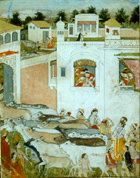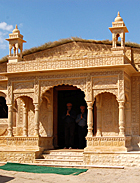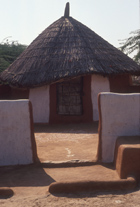
In the distant reaches and vast expanse of the Thar Desert, far off the beaten tourist trail, we have constructed the unique and inspirational Dera Sand Dune Retreat. Magnificently perched atop a 130’ stabilized sand dune, our resort is a wonderful base to explore this remote area of Rajasthan and, most importantly, to interact with the living cultures of rural India.
From its inception, sustainable tourism and conservation, both of the natural environment and traditional village cultures, have been the primary motivating factors behind Destination Himalaya's India partner, Far Horizon’s, involvement in the Jamba area and a primary reason for the establishment of the Dera Sand Dune Retreat. Construction and operation of the property has been designed with the utmost care to be minimally invasive and inconspicuous. The Retreat was designed to accentuate the desert topography, and is aesthetically unobtrusive; in fact, it actually succeeds in complementing and enhancing the beauty of the area. As the Retreat lies in a desert area, specific care is taken to minimize environmental impacts. The Retreat’s landscaping is hand-watered (using only grey water) to conserve water that might otherwise be wasted through automatic irrigation techniques.
The Accommodations
Eight Deluxe pool facing Stone Cottages, offer an architectural delight of pillars carved out of Jaisalmer yellow sand stone, traditional Rajasthani sunken baths, with a view of the desert and carefully carved window screens to provide maximum privacy. Polished yellow sand stone floors with locally woven rugs and simple furniture add to the comfort. A contemporary fort-like setting.
Ten Standard desert facing Wood Cottages with thatched roofs, a dressing room with a wardrobe, floors of polished yellow sand stone from Jaisalmer and large glass windows offer a picturesque stay.
Attractions and Highlights
Jambho ji Temple
Jambho ji was a great visionary, who had foreseen the consequences of man’s actions, destroying nature for economic development. He saw the need for environmental protection and weaved his principals into religious commandments so that people could justify and accept those principals easily. He launched the eco-religious revolution known as Bishnoism at Samrathal Dhora in 1485 A.D. In a Bishnoi temple, no idol worshipping is allowed. Only a lamp with Ghee (Purified butter) is kept lit while praying, no elaborate ceremonies or rituals are performed by the priests. Bishnois are basically worshippers of Lord Vishnu.
Village Excursions:
The Bishnoi Tribe – The Bishnois are known as the conservationists to whom the preservation of animal and vegetable life is a religion and has been so from the early 15th century. The Bishnoi Women with their attractive attire, silver trimmings and some of the most gorgeous jewellery - heavy nose rings, earrings, bangles and anklets and solid, chunky necklaces - are an attractive sight. “Women are the symbol of creation,” which is why Jambho ji asked them to wear vibrant colors such as red and orange. The Bishnoi men, on the other hand, wear only white, as it symbolizes of cleanliness and austerity."
The Raikas or Rabaris: The traditional caretakers of the camel herds belonging to the Maharajahs, the Raikas today represent one of the largest ethnic group of herders in India. Through their innovativeness, flexibility and specialized knowledge, they have managed to thrive in a harsh, semi-desert environment.
Salk Lakes:
The sandy soil of the Thar Desert absorbs all the water but here at the foot of the sand laden dunes lies an area by some mysterious quirk of nature that does not absorb any water and is saturated with salt. Locals harvest this seemingly endless supply of salt for sale in the local markets..
Local Flora & Fauna:
Demoiselle Crane – the graceful Siberian migratory bird that travel thousands of mile south every winter to this desert area. The township of Kheechan is famous for these birds, you can also spot these beautiful cranes in front of the Jambho ji temple and resting in and around the lake. Easily seen between October – March.
The ship of the desert – Camels are an integral part of desert life. Large herds of camels are awe-inspiring.
Chinkaras – the petite looking desert gazelles roam freely around the dhannis and in the fields.
Desert Fox – the desert fox is on top of the food chain.
Birds – the sparrows, pigeons, Indian roller, doves, wagglers, black drangos, wheat eaters, egrets etc.
Variety of Plants – trademark images of tumble weed, milk weed and the acquiescing acacia, ‘kehar’ ‘khejri’ and ‘jal’ trees dot the landscape.
Giving Back
At Jamba, the fruits of Destination Himalaya & Far Horizon’s partnership with the local community are evident. The construction of the Retreat could literally never have been completed without the direct involvement of Jamba’s residents. The local community was involved in every step of the Retreat’s journey from dream to reality, from initial agreement and approval to the actual hands-on construction process. The Retreat features exquisite examples of traditional Rajasthani architecture used throughout, with stonework and carvings using local design and sustainable materials and, most importantly, utilizing the skills of local craftsmen. Dera’s furnishing and décor, notably carpets and tapestries were woven by local villagers.
At the Dera Sand Dune Retreat, the local population is truly incorporated into the Far Horizon family. The Retreat simply could not function without the support and participation of the local community. More than 30 Rajasthani are directly employed through this venture; each one is treated with the utmost respect and earns a wage that is at the high end of their work responsibility.
Far Horizon’s involvement in the Jamba area has resulted in enabling the local populace to become a self-sustaining community, and affords the Retreat’s visitors with an absolutely unique experience. A visit to the Dera Sand Dune Retreat is not an organized “tourist show”; it is a natural and organic area with “real” villagers living as they have for centuries, where interaction between the traveler and the local population is real and not forced. In fact, many travelers who visit Jamba choose not only to return, but also have become directly involved with the local community under the aegis of Far Horizon.
| Itineraries featuring the Retreat:
Itineraries featuring North India:
|
Call us toll free at 1-800 MY INDIA (1-800-694-6342) or email us to request a detailed day-to-day itinerary. |
Namaste, Sanjay - from your beautiful Jamba! I have enjoyed the serenity of a delightful week here.......a walk each morning over the dunes (working off Nima's delicious menus!), visiting the dhanis, Phalodi, salt flats and the tribals at Bhat. Unforgettable!
- G. Marshall, CT

Rajasthani miniature
Features:
• Exclusive spa for ultimate relaxation
• An outdoor swimming pool right in the middle of the desert expanse
• Camel trekking on and around the dunes
• Camel safari – a day long or can be extended over a week
• Guided nature walks on the dunes
• Camel cart rides to the salt area—unique desert feature covering 15 km radius
• Village safari in air conditioned four wheel drive vehicle
• Nightly cultural program (folk music and dance) by the local people
| Getting there:
• Flight: Jamba is a two-hour drive from Jodhpur Airport.
• Helicopter: on site helipad for direct flights from Delhi
• Train: Phalodi, a 30 minute drive, is the nearest railway station
|
 Property entrance
 The swimming pool
Photo: William Neill

Room Interior

Local villager

Dhani (local adobe hut)
|